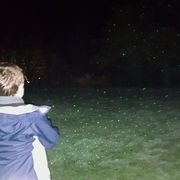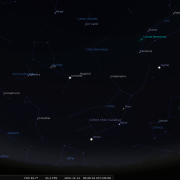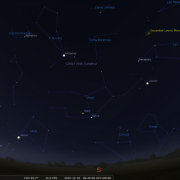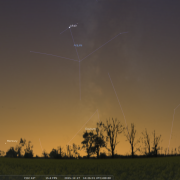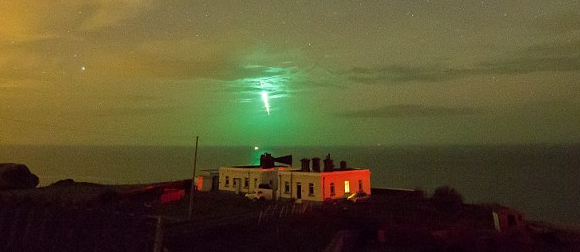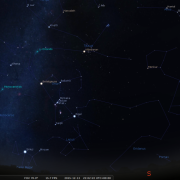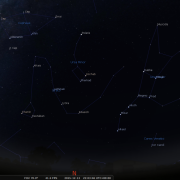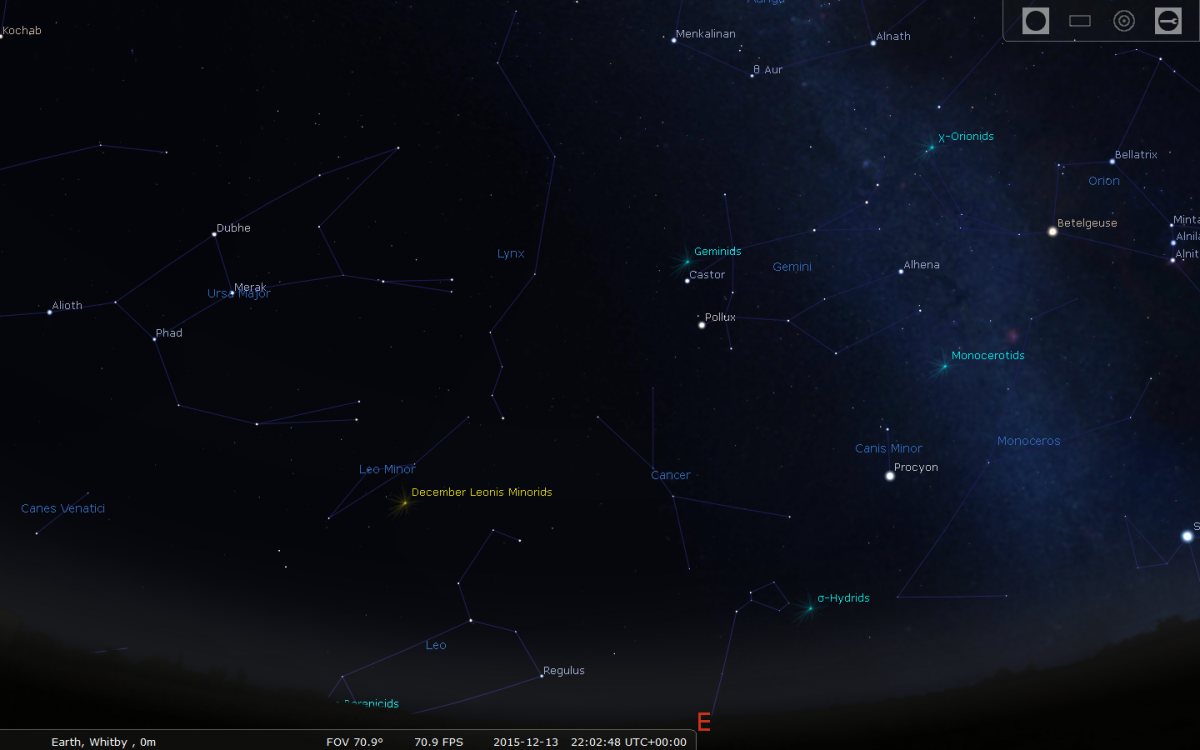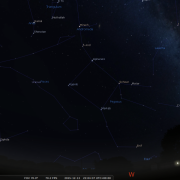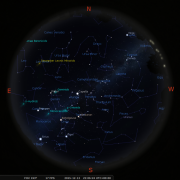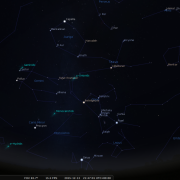Welcome to the WDAS monthly newsletter for December 2015: a digest of the month's latest contributions to our website. Below you'll find Society News, Sky Notes and In-Focus articles printed in full. There's also future events, and trailers for other articles which appear in full on the website - just a click away!
On the website you'll also be able to comment on articles, and if you'd like to play an editorial role in creating new content, just let us know!
Quick Summary for December:
- WDAS Christmas Dinner on Saturday 5th December from 19:00h at the Hare & Hounds in Hawsker. Note date change. If the new date means your available, today (1st Dec) is the very last chance to book a place.
- WDAS Society Meeting on Tuesday 1st December from 19:30h.
Society News
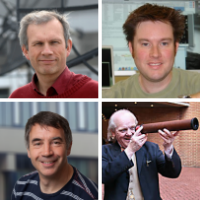 Four members (Andi, Keith, Lee and Mark) journeyed over to Leeds on a foul morning for this year’s Astromeet. Indeed even though Andi managed drop us off within just a few metres of the entrance, such was the intensity of the cloudburst at the time, we still got soaked. Once inside the venue we had just enough time to dry off and quickly peruse the two vendor’s rooms, meeting Mark’s friend Mike who lives in Melsonby in one of them.
Four members (Andi, Keith, Lee and Mark) journeyed over to Leeds on a foul morning for this year’s Astromeet. Indeed even though Andi managed drop us off within just a few metres of the entrance, such was the intensity of the cloudburst at the time, we still got soaked. Once inside the venue we had just enough time to dry off and quickly peruse the two vendor’s rooms, meeting Mark’s friend Mike who lives in Melsonby in one of them.
A full account of the lectures will feature in next month’s notes.
During the first interval Mark bagged a 21mm eyepiece for the society – the same type and brand as the previous ones purchased in past years. We now have a set of 21mm, 18mm, 12.5mm and 7.5mm. This was actually the only purchase of the day.
Our usual dinner time ritual of dining in the Terrace bar at the students union was scuppered this year thanks to Rag week festivities (live music: passes and door guards) Although Andi managed to blag his way in (we all reckon they thought he was in the band) For the rest the local Tesco Express provided sustenance, before all too soon the afternoon lectures started.
Before the final lecture, delivered in customary fashion by Dr Alan Chapman, the raffle was drawn. Mark managed to lose his tickets (which was a shame as all were winners... at least that’s what he maintained). But we did manage a genuine win, bagging an oversized 2016 calendar/almanac from the items still on the table.
And so another Astromeet was over, with talk of the day’s events passing the time on the journey home.
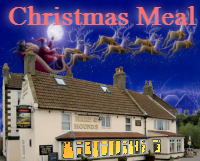 After last year’s successful Christmas meal at the The society Christmas meal has now been booked. The venue is the Hare and Hounds in Hawsker, on Saturday December 5th for 7:30pm. Details of the menu are on our website.
After last year’s successful Christmas meal at the The society Christmas meal has now been booked. The venue is the Hare and Hounds in Hawsker, on Saturday December 5th for 7:30pm. Details of the menu are on our website.
As of going to press, 10 people have booked for the meal. The menu choices have been passed on, so if anyone wishes to come along Tuesday 1st is the cut off date.
Travelling arrangements will be finalised at the December meeting (on the 1st) including picking up points and times. Andi and Mark usually act as the Taxi service, although we may book a taxi.
For the final day of October you would be forgiven in thinking that summer had made an unscheduled return, such were the balmy conditions which coincided with both Goth weekend and the ‘Creatures of the Night’ event held at the Danby Moors Centre.
Warren's distributed-beam
laser torch was a hit: instant
Christmas tree lights!
(Click for full-sized image)
Organised by Emma McKenzie, assistant events co-ordinator for NYM parks authority, they could not have wished for a better day weather wise. Four members (Andi, Keith, Mark & Warren) journeyed over to Danby, utilising various scenic routes, apparently some more scenic than others! On arrival it was pleasing to meet up again with Marcus from Grovers Optics, who had been pitched in front of the Centre since early afternoon; however our slot was from 17:30 to 19:30h.
Luckily we were able to drive onto the field, and scope deployment was far easier than we had being anticipating. First on the agenda was to terrify all and sundry with tales of impending doom (well it was Halloween). This time, of course, the ‘unseen terror’ also known as asteroid TB145t, (christened ‘Spooky’ by Nasa) hurtled passed Earth at 17.05h, approximately 300,000 miles (483,000km) distant. A chilling reminder that ‘things can still go bump in the night’ and given enough time probably will one day.
As darkness fell observing began in earnest with children and parents coming over to look at some of the autumn wonders on show. The only slight negative was the absence of the Moon and a bright planet to view, but with transparent skies and pretty dark conditions, deep sky objects appeared very satisfactory, so we shouldn’t grumble.
By 19:30 the event drew to a close and we packed up. One final spectacular sight greeted us on the way home: a fabulous last-quarter moon, just rising and veiled in a little mist, very ‘Gothic Romantica’, a fitting finale to Halloween.
The November meeting proved most educational and entertaining. After our usual look at the comings and goings in the heavens, society news and business etc, our attention turned to the more exotic and intoxicating. Andi had prepared a presentation on Comets, to commemorate the 1st year anniversary of Philea landing on comet Churyumov-Gerasimenko (67P).
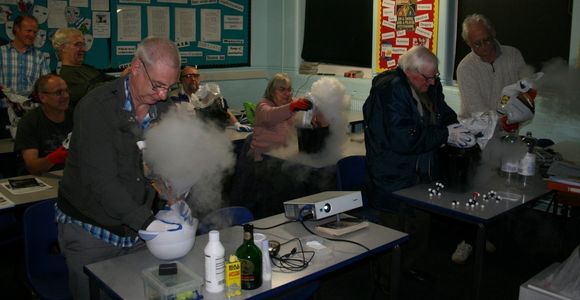
Comet building in progress. Lots more pictures in the Gallery.
In particular Andi thought it would be informative and fun to make a comet in the classroom using ingredients that are now known to be found in comets. He had furnished everyone with a bucket, a bag, gloves and then the ingredients:
- Cinders from an open fire, and sand from the beach (representing carbon and silicates which form much of a comet's core)
- Lighter gas, representing simple hydrocarbons (methane, methane, propane, butane, etc)
- Scotch Whisky - single malt, no less! (representing alcohols: methanol, ethanol "the drinking alcohol" found on Comet Lovejoy, propanol and butanol)
- Smelly Ammonia and Formaldehyde (although the latter being a carcenogenic, among its other attributes, we used a homeopathic substitute!)
- Nail varnish remover (which is 'Acetone') courtesy of Mark's wife)
- Salt (sodium was found in Hale Bopp's tail)
- Sugar (representing Glycolaldehyde, a simple sugar found on Comet Lovejoy)
... and then the frozen carbon dioxide (dry ice) was added and the class was filled with ‘ smoking bags’ all being squished and moulded into various shapes. It was like a scene from a Hogwarts witch’s home brew class. But what a transformation! Comets! They actually looked like miniatures of the real thing: dirty snowballs of various constituents. It was a fantastic demonstration of how these building blocks come together. We all thought it magnificent; Andi had clearly put a great deal of effort in it.
So, November: comets; December ...? Black Holes? Who knows, but there’s only one way to find out – Dec 1st hope to see you.
Sky Notes
In this month's Sky Notes:
- Planetary Skylights
- Meteor Activity
- Giant Meteor seen from Whitby
- Comet C/2013 US10 Catalina
- Winter Solstice
- December 2015 Sky Charts
Planetary Skylights

 Uranus and Neptune continue to be the only major planets visible (with optical aid) in the evening sky. At magnitude 6, binoculars will show Uranus, however only a telescope will reveal its tiny disk. It resides around 1 degree below epsilon Pisces. At almost mag 8 Neptune resides in Aquarius between the two naked eye stars of sigma and lambda Aquarii.
Uranus and Neptune continue to be the only major planets visible (with optical aid) in the evening sky. At magnitude 6, binoculars will show Uranus, however only a telescope will reveal its tiny disk. It resides around 1 degree below epsilon Pisces. At almost mag 8 Neptune resides in Aquarius between the two naked eye stars of sigma and lambda Aquarii.



 Rising in the wee small hours, conspicuous Jupiter resides upper left of Mars and Venus. At the end of last month Jupiter was involved in a spectacular conjunction with Mars and Venus, but already clear blue sky exists between them. Jupiter is a fine telescopic object and unlike Venus has plenty of detail on show. Look for the bands and belts across the disk, the great red spot, which appears quite pale and the attendant Galilean moons next to Jupiter. The Moon lies nearby Jupiter on the 6th By the month’s end Jupiter is rising shortly after midnight.
Rising in the wee small hours, conspicuous Jupiter resides upper left of Mars and Venus. At the end of last month Jupiter was involved in a spectacular conjunction with Mars and Venus, but already clear blue sky exists between them. Jupiter is a fine telescopic object and unlike Venus has plenty of detail on show. Look for the bands and belts across the disk, the great red spot, which appears quite pale and the attendant Galilean moons next to Jupiter. The Moon lies nearby Jupiter on the 6th By the month’s end Jupiter is rising shortly after midnight.
Mars, Venus and finally, Saturn all reside in the dawn sky – lower left of Jupiter. The orange hue of Mars lies to the left of white Spica (chief star in Virgo). Brilliant Venus resides lower left of Mars, not that far above the SE horizon. Turn a scope toward Venus and you will discern a waning crescent phase. The moon lies nearby on the 8th.
 Saturn returns to the dawn sky by the final week in December, look for it around 07:00h lower left of Venus, just above the SE horizon. It is therefore the lowest planet in the chain extending down from Jupiter. The moon lies nearby Saturn on the 10th.
Saturn returns to the dawn sky by the final week in December, look for it around 07:00h lower left of Venus, just above the SE horizon. It is therefore the lowest planet in the chain extending down from Jupiter. The moon lies nearby Saturn on the 10th.
 Mercury has a reasonable evening apparition, but again you will have to wait until the final week to have a decent chance of spotting this elusive planet. Look for it just before 16:30h a few degrees above the WSW horizon.
Mercury has a reasonable evening apparition, but again you will have to wait until the final week to have a decent chance of spotting this elusive planet. Look for it just before 16:30h a few degrees above the WSW horizon.
During the last week of the year, given a clear sky, some sky knowledge and perhaps an alarm clock, you will be able to view all the major planets in one night.
Meteor Activity

Meteor activity reaches a peak at this time of year and given clear skies the chance of spotting a shooting star or two should be quite high. Considered now to be the most prolific annual meteor shower, the Geminids are active from December 7-16th, reaching a peak on December 14th.
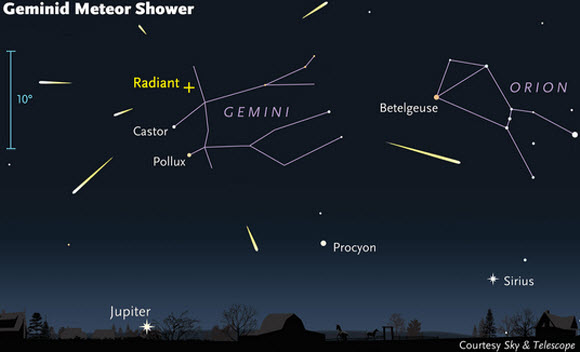
Finding Gemenid Meteor Shower (Courtesy: Sky & Telescope Magazine). Peak: 14-Dec-2015
Unlike the majority of meteor showers, which are associated with comet debris, Geminids stem from debris shed by a strange object that may be a dead comet or small asteroid called Phaethon. This object passes within 10 million miles of the Sun and over time has deposited material over great swathes of the inner solar system. However it is only within the last 100 years that Geminid activity has increased to the levels recorded today with Earth passing through a much denser debris strand, a situation that will only last another 100 years!
The shower radiant lies close to Castor, the upper most of the 'twin' stars in Gemini visible in the east by 21:00h. Under ideal conditions the Zenith Hourly Rate (ZHR) can reach 120 plus (early morning hours), however actual observed rates are always lower than this. Prospects this year look good, with the moon setting early evening. After 23:00h on the 13th expect 10-20 per hour, rising to 40-60 per hour by around 02:00h on the 14th when Gemini is at its highest in the sky. The following evening and overnight should also yield reasonable numbers so do keep watch. Concentrate on regions of the sky a couple of hand spans away from Gemini itself. Really bright Geminids can sometimes appear green or orange in hue.
Later in the month the Ursids (active Dec 17-25th) peak on Dec 22/23rd with hourly rates of 8-12 normal. Occasionally Ursids produce strong outbursts. The radiant lies close to the Great Bear.
Meteor lights up the Sky
You may have seen the pictures in the media of a brilliant meteor observed over the North Sea from Whitby on Nov 6th around 01:30h.
Taurid Meteor taken by Peter Horbury over Whitby Foghorn Station (now "Hornblower Lodge")
on Sat 07-Nov-2015 01:30h (Click picture for full image)
Looking at the picture taken by Peter Horbury from the Hawsker Bull (ex foghorn station) the brilliant meteor looked to be around magnitude – 6 in magnitude and had a greenish hue. Apparently Peter was trying to take some time lapse shots of a minor aurora display when the meteor photo-bombed proceedings.
From the trajectory, time and date, the most probable origin of the meteor would be from the Taurid shower, which is active in early November. Did any members see anything?
Comet C/2013 US10 Catalina
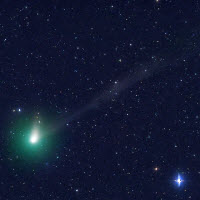 Having passed perihelion on 15th November at a distance of 0.82 AU, Comet Catalina will be become better placed for northern hemisphere observers as it heads north into the early morning sky.
Having passed perihelion on 15th November at a distance of 0.82 AU, Comet Catalina will be become better placed for northern hemisphere observers as it heads north into the early morning sky.
The comet has brightened from Magnitude 7 to Magnitude 5 in the last few weeks and may become a naked eye object. Catalina should certainly be a binocular object at least. As a rough guide, look for the comet in the same part of the sky as Venus, which drops down to the right of Catalina over the course of the first 10 days in December.
We will not see Comet Catalina again for several million years so catch it while you can.
The Winter Solstice
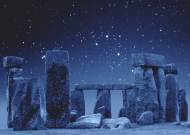 The Sun reaches its lowest position in the sky on December 22nd this year; the date of the winter solstice, by which time the Sun arcs little more than 12 degrees above Southern horizon at local noon from our latitude. With the northern hemisphere tilted away from the Sun, useful daylight amounts to just 7½ hrs, the shortest day. Latest sunrise and earliest sunset do not however occur on the winter solstice date.
The Sun reaches its lowest position in the sky on December 22nd this year; the date of the winter solstice, by which time the Sun arcs little more than 12 degrees above Southern horizon at local noon from our latitude. With the northern hemisphere tilted away from the Sun, useful daylight amounts to just 7½ hrs, the shortest day. Latest sunrise and earliest sunset do not however occur on the winter solstice date.
The Sun rises latest near the end of December (27 or 28th) and sets earliest mid-month (15 or 16th). Astronomically speaking the winter solstice also marks the first day of winter in the northern hemisphere, but within a few weeks daylight will once again start to lengthen in duration. Now that must be cause for celebration! What shall we call it... any ideas?
|
Looking South
Mid December - 22:00h |
Looking North |
|
Looking East
Mid December - 22:00h |
Looking West
Mid December - 22:00h |
|
Overview
Mid December - 22:00h |
Looking South-East
Mid December - 21:45h |
Additional Image Credits:
- Planets and Comets where not otherwise mentioned: NASA
- Sky Charts: Stellarium Software
Telescope Garage
With Christmas comming up, you may have asked santa (or hoped for) a telescope to view the Heavens;- or his reindeer. But what scope would be the right kind? How much should i pay, and where do i buy in confidence.
Events
 Observe the night sky with us at the Bruce Observatory, Whitby School
Observe the night sky with us at the Bruce Observatory, Whitby School
Observing Nights are held weather permitting: check for a relatively clear sky before leaving home. If in doubt, Mark can be reached on 07886069339
Please note the college drive gate is now operated via a electronic key code - so anyone wishing to attend must be at the car park at the top of the drive by 19:00hrs - unless an arrival time has been arranged with Mark/Keith.
 Observe the night sky with us at the Bruce Observatory, Whitby School
Observe the night sky with us at the Bruce Observatory, Whitby School
Observing Nights are held weather permitting: check for a relatively clear sky before leaving home. If in doubt, Mark can be reached on 07886069339
Please note the college drive gate is now operated via a electronic key code - so anyone wishing to attend must be at the car park at the top of the drive by 19:00hrs - unless an arrival time has been arranged with Mark/Keith.
 Observe the night sky with us at the Bruce Observatory, Whitby School
Observe the night sky with us at the Bruce Observatory, Whitby School
Observing Nights are held weather permitting: check for a relatively clear sky before leaving home. If in doubt, Mark can be reached on 07886069339
Please note the college drive gate is now operated via a electronic key code - so anyone wishing to attend must be at the car park at the top of the drive by 19:00hrs - unless an arrival time has been arranged with Mark/Keith.
 Whitby School - Room H1.
Whitby School - Room H1.
In Members' monthly meetings we usually take a tour of the night sky for the coming month using the Planetarium program. Have talks and presentations on various topics of astronomy/space etc, and discuss future events etc. New members welcome.

